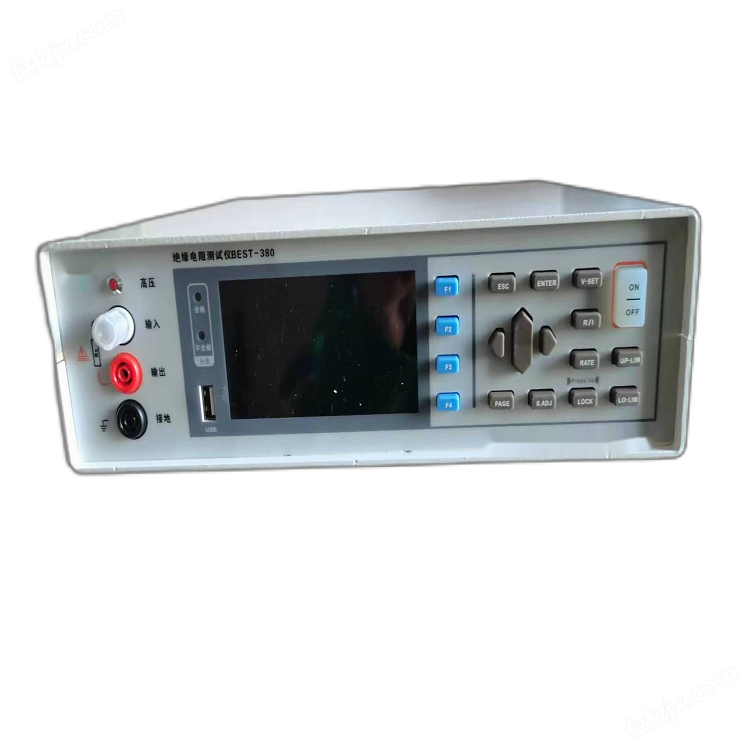BEST-380 Best-380体积表面电阻率测试仪
产品简介
详细信息
Best-380体积表面电阻率测试仪数字超高阻、微电流测量仪 型号:BEST-380:体积电阻率测试仪,表面电阻率 测试仪,固体绝缘材料电阻率测试仪 用途:仪器仪表检测试验
一、Best-380体积表面电阻率测试仪概述
本仪器是既可测量高电阻,又可测微电流。采用了美国In公司的大规模集成电路以及技术,使仪器体积小、重量轻、准确度高。以双3.1/2 位数字直接显示电阻的高阻计和电流。量限从1×104Ω ~1×1018 Ω,是目前国内测量范围zui宽,准确度zui高的数字超高阻测量仪。电流测量范围为2×10-4 ~1×10-16A。机内测试电压为10/50/100/250/500/1000V任意可调。本仪器具有精度高、显示迅速、性好稳定、读数方便, 适用于防静电产品如防静电鞋、防静电塑料橡胶制品、计算机房防静电活动地板等电阻值的检验以及绝缘材料和电子电器产品的绝缘电阻测量。本仪器除能测电阻外,还能直接测量微弱电流。
仪*符合并优于国家标准GB1410《固体电工绝缘材料绝缘电阻、体积电阻系数和表面电阻试验方法》和美国标准ASTM D257《绝缘材料的直流电阻或电导试验方法》等标准的要求。
二、体积电阻率表面电阻率测试仪主要特点
电阻测量范围宽 0.01×104Ω ~1×1018 Ω
电流测量范围为 2×10-4A ~1×10-16A
体积小、重量轻、准确度高
电阻、电流双显示
性能好稳定、读数方便
所有测试电压(10/50/100/250/500/1000V) 测试时电阻结果直读,免去老式高阻计在不同测试电压下或不同量程时要乘以系数等使用不便的麻烦, 使测量超高电阻就如用万用表测量普通电阻样简便。
既能测超高电阻又能测微电流
适用范围广:适用于防静电产品如防静电鞋、防静电塑料橡胶制品、计算机房防静电活动地板等电阻值的检验和电子电器产品的绝缘电阻测量
三、体积电阻率表面电阻率测试仪技术指标
1.电阻测量范围: 0.01×104Ω ~1×1018Ω。
2.电流测量范围为: 2×10-4A~1×10-16A
3. 双表头显示: 3.1/2位LED显示
4. 内置测试电压: 10V、50V、100V、250、500、1000V
5. 基本准确度:1% (*注)
6 使用环境: 温度:0℃~40℃,相对湿度<80%
7 机内测试电压: 10/50/100/250/500/1000V 任意切换
8.供电形式: AC 220V,50HZ,功耗约5W
V
Resistance, current double display
Good performance is stable, easy reading
All the test voltage ( 10/50/100/250/500/1000V ) test resistance results in reading, is removed from the old high resistance meter in different test voltage or different scale should be multiplied by the coefficient of the inconvenient trouble, allowing the measurement of high resistance as the multimeter is used to measure the general resistance of samples is simple.
Not only can measure high resistance and micro current
Wide application: applied to anti-static products such as anti-static shoes, anti-static plastic rubber products, computer room anti-static floor activities such as resistance testing electrical and electronic products insulation resistance measurement
Three, volume resistivity surface resistivity tester technical indicators
The 1 resistor measurement range: 0.01× 104 Ω~ 1× 1018 Ω.
The 2 current measurement range : 2 × 10-4A~ 1 × 10-16A
3 double header display: 3.1/2 LED display
4 built-in test voltage: 10V, 50V, 100V, 250, 500, 1000V
5 basic accuracy: 1% ( note )
6: use environment temperature: 0℃ ~ 40 ℃, relative humidity<80%
7 built-in test voltage: 10/50/100/250/500/1000V arbitrary switching
The 8 power supply forms: AC 220V, 50HZ, power consumption is about 5W
Four, volume resistivity surface resistivity meter working principle
According to the Ohm's law, the measured resistance is equal to voltage is applied through Rx V divided by the current I. The traditional high resistance meter is the working principle of measuring voltage V fixed, by measuring the current flows through the sampling resistor I to get the value of resistance. From Ohm's law can be seen, because the current I is inversely proportional to the resistance, but not proportional to the resistance, so the display value is nonlinear, namely the resistance to infinity, the current is zero, i.e., zero is∞, in the vicinity of the scale is very dense, with a low resolution. The scale is nonlinear. Because the measurement of different resistance, the voltage V also vary, so the average high resistance meter is poor accuracy, low resolution.
At the same time measure the voltage across the resistor V and the current through the resistor I, through the interior of the large scale integrated circuit to complete the voltage divided by the current calculation, and then the results obtained after A/D conversion to digital show resistance, even if the voltage across the resistor V and the current through the resistor I is changed at the same time, the display resistance value is not as common due to high resistance meter that measured voltage or current change of V I change, so, even if the measured voltage, resistance, power supply voltage is measured the changes in the results have little effect, the measurement accuracy is very high ( patent ), theoretically the error can be zero, while the actual error can be done a few thousandths or extremely few.
Typical application
1 measurements of anti-static shoes, conductive shoes resistance value
2, measurement of the antistatic material resistance and resistivity
3, measurement computer room with movable floor system resistance
4, measurement of insulation resistance ( rate)
5, photodiode dark current measurement
6, physics, optics and materials research
Canton company other insulating materials testing instruments:
BDJC-0-100KV dielectric breakdown testing instrument
BDJC series insulating materials at power frequencies of dielectric breakdown test instrument
BDJC series voltage dielectric strength test apparatus
BDJC series voltage breakdown testing instrument
BDJC series insulating paint film breakdown strength tester
BDJC capacitor voltage breakdown testing instrument
EST-121 volume surface resistivity measuring instrument
GDAT-A dielectric loss tester / dielectric constant test

